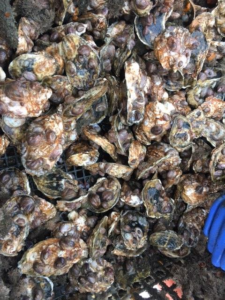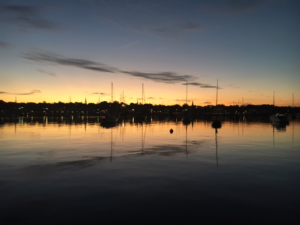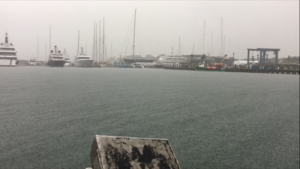-
Home
-
We Have Been Innovating
We Have Been Innovating
November 26, 2018
It has been a long time coming with this farm update. The highs and lows happen, but the general trend is upwards. As we look to the future, we see a cold winter approaching, and are currently preparing ourselves, and our farms.
Here and Now
To prepare our farms, we are trying to stock pile as many market oysters in easy to harvest locations as possible. We have found that we are very good at killing oysters in the winter because the sub-zero temperatures make the lives of these hearty bivalves fleeting. Once removed from the 35-degree water and sorted out, the smaller oysters have a difficult time of re-acclimating to the cold environment. It does not help that on the boat ride to and from the farm the temperature is usually quite low, and the wind chill even lower. Although the real kicker, I think, is that while on land the oysters are put through the tumbler and then graded out for markets. The oysters going to market don’t mind because they will go on living in our seawater system (heated to 50 degrees) or the refrigerator (40 - 45 degrees) until they arrive on the end users’ plate. The smaller oysters (returns) will be brought back out to the farm expecting to be revitalized by the nutrient rich bay waters only to find there is no food to eat, and no warm fire to sit by and warm their aching extremities. This is very stressful, and for many of the oysters this reintegration is fatal.

The solution to this problem is, we hope, to separate all the large and small oysters while the water is still relatively warm. This way when we harvest through the winter, we are only taking out the market sized oysters and leaving the smaller stocks to grow another season. Genius? No. Simple? Yes, in concept, but sometimes the execution of the simplest concepts can be pretty difficult. That’s where the Innovator comes into play!
Generally, this time of year we stop oyster farming, haul the boat, and put all of our efforts into fixing it up. We run our equipment hard all year long, and mechanical errors happen (to put it nicely). Now that we have two boats, we can keep the farming operation going while one boat is out of the water.
Previously at Salt Water Farms

Stepping back in time lets remember what happened at Salt Water Farms this summer. Highlight: The FV Tom Royal (TDR) was relocated to Newport, hanging out at pier 9 with the commercial fishing fleet of Rhode Island, and right next door to the mega yachts at Newport shipyard. The contrast of wealth between the two docks is vast, as well as the time spent on board by a boat owner. I very rarely saw any of these super yachts leave the dock although each morning they were being polished by their well-paid crew. Meanwhile there were fishermen were out making a living on the water every day using their boats. I wonder who gets more out of owning a boat, and who has more skills on the water?

Before the TDR was moved, we completed the biggest oyster planting to date. We completely stocked the Jamestown site with Fishers Island seed, and it looks fantastic after getting tumbled twice over the summer, and finally a third time in the process I described above. Chipping lips is what creating a quality oyster is all about, and the more you handle your product the better it will be when it comes time to harvest.
The Blue Gold mussel season was great, although too short, and the local chefs really came on board to start using these delicious un-sung heroes of the RI shellfish world. We are still trying to figure out ways to prolong the season and pump up the mussels through the Spring and Fall.
Forecast for the Future
We are transitioning to our winter activities, and the Thomas D. Royal is due to go back in the water this Thursday. I am excited to get that boat back working because of its versatility on the water, its speed (a whopping 7-8 knots!), and its creature comforts like autopilot, storage space, and a dry cabin. We will be musseling - that is reseeding and planting out our natural set of spat to lesser densities in hopes they will grow bigger and faster.
It has been a cold fall so far, but we are hoping for a mild winter, praying for tranquil seas, looking out into the horizon, with our face into the biting breeze.
A change is in the air its gaining momentum by the year, America needs a seafood supply, quality resources that come from here.
Can we rely on the same old sources, can we rely on foreign imports? It's hard to rely on the federal government to lend its support.
On that note we have been trying to gain the rights to fish mussels in federal waters off Massachusetts but have been pushed back and delayed by the government. We know that the mussels are there, we know that utilizing this resource will not hurt the natural environment, and in fact, it will help American seafood producers to compete with the Prince Edward Island mussels that dominate our market. Its like trying to turn an aircraft carrier with a canoe paddle.